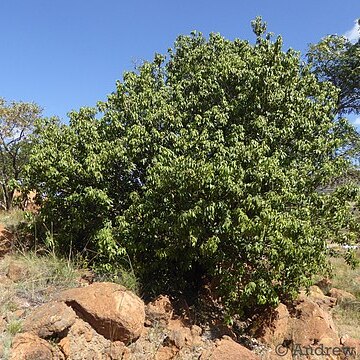Leaves alternate, 3-foliolate; petiole 1–3 cm. long, terete or somewhat grooved at the apex; leaflets usually sessile; lamina 3–8 x 1–4 cm., coriaceous, narrowly elliptic to elliptic, densely dotted with pellucid glands, obtuse or ± acute at the apex, cuneate at the base; nerves and veins conspicuous on the upper surface.
Shrub or small tree, up to 6 m high. Leaves 3-foliolate, petiole 10-30 mm long, terete, leaflets narrowly elliptic, 30-80 x 10-40 mm, leathery, gland-dotted, venation conspicuous. Fruit ellipsoidal, fleshy, 12 mm long. Flowers greenish yellow.
Inflorescence of axillary racemes or panicles, shorter or a little longer than the petiole of the subtending leaf.
Female flowers: staminodes 8; ovary globose, glabrous, 2-locular; loculi 2-ovulate; stigma subsessile, discoid.
Male flowers: stamens 8, those opposite the petals shorter; vestigial ovary glabrous, with 2 short styles.
Flowers sessile, 4-merous, unisexual by abortion, dioecious, usually clustered on the rhachis.
Shrub or small tree up to 6 m. tall; branches, leaves and inflorescences glabrous.
Sepals ciliolate, united into a shortly lobed cupuliform calyx 1·2 mm. long.
Fruit 1–2 cm. long, drupaceous, ellipsoid, 1-locular.
Petals 4·5 × 0·8 mm., oblong, reflexed.
Mature seed not seen.


